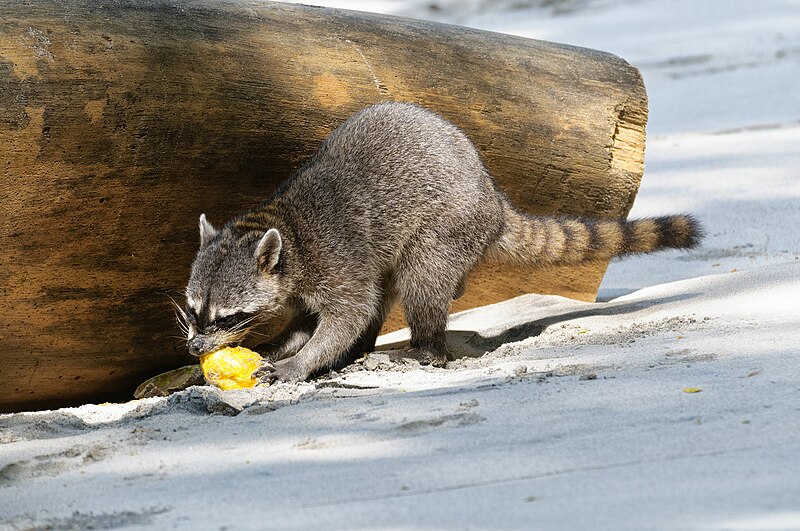Raccoons are among the most interesting and intelligent mammals in North America. They have a diverse range of habits, behaviors, and habitat needs that allow them to live in many different environments. In this article, we will talk about where raccoons live in the winter, how they survive, what they do, where they go, and other fascinating facts about raccoons in the winter season!
Where do raccoons go in winter
Raccoons spend most of their time sleeping or resting throughout the winter season. This helps conserve energy so that the raccoon can survive until springtime when there is more food available again. During periods where temperatures drop particularly low, some have been known to enter torpor to reduce their body temperatures and metabolism.
In the harsh months of winter, they will seek shelter in a safe place where they can den. They are very resourceful and often make their own dens for this purpose by digging holes under porches or decks, in abandoned burrows or groundhog holes. In the wild, raccoons will also den up in hollow trees and under large rocks.
In areas where there are many natural shelters available such as tree cavities, hollow logs, and rock crevices, a single group of raccoons may have several dens for use at different times of the winter. Where they live near human habitation, they will seek out attics and chimneys for their dens as these provide cover against the cold and wind as well as protection from predators such as bobcats or coyotes.
Raccoon dens
The first step to understanding where raccoons go in winter is learning about what a den is. A den is a shelter that raccoons use for resting, breeding, and as the center of their home range. Dens in the wild are usually underground or in elevated structures such as fallen hollow trees, hollow logs, brush piles, rock crevices, or even chimneys. In suburban and urban areas, they den in abandoned buildings, chimneys, attics, and other man-made structures.
During winter months when food sources become scarce it may be necessary for animals to leave the warmth of their den so they can scavenge. If the temperature is extremely cold, a pack of raccoons will sometimes share a den to share body heat and keep warm.
What do raccoons do in winter?
Raccoons will spend the winter in their dens sleeping and laying low. These shelters can be located in underground burrows or trees cavities, but sometimes they make use of attics and even chimneys! If there aren’t any natural den sites available then they will seek refuge under decks or porches. A raccoon will come out of its hiding every now and then when it’s warmer to scavenge or if it needs to stretch its legs.
How do raccoons survive winter?
Although raccoons have one of the shortest lifespans among mammals in North America, they are well adapted to cold climates. This is because of their many unique features, which differ from most other North American mammals. They are able to survive the winter months through several different strategies. Some of these include:
- Growing thicker coats
- Build up body fat stores
- Finding warm dens
- Going into torpor
- Eating anything they can get their paws on
- Sharing space with other raccoons
They grow a thick winter coat
Raccoons that live in areas with colder climates have coats that are much thicker than those who live in warmer areas. This provides them with insulation, which helps to keep their body heat inside the fur where it belongs!
Build up fat stores
Raccoons prepare by building up large amounts of body fat before winter sets in so that they can survive for long periods without eating. In the spring and summer, they will eat as much as they can to build up their fat stores so that they are prepared for winter.
Finding warm dens
Dens provide refuge from the cold air, wind, rain, and snow of winter. They also protect them from predators who may be out hunting during the day or nighttime hours. They locate these den areas by looking for elevated spots where there is little exposure to strong winds and precipitation. Dens often consist of hollowed-out logs or tree cavities located near water sources such as small creeks or ponds which have abundant plant growth nearby to support them even when food is scarce.
Going into torpor
Torpor is an adaptation found in several different types of animals that allows them to survive through winter. It can be defined as a short-term state of decreased body temperature and metabolic rate, which allows the animal to conserve energy during times where resources are limited.
Torpor is similar to hibernation because both processes involve lowered heart rate and body temperature. However, hibernation is a deep sleep that lasts for three to five months while torpor may last only one or two days at a time. Raccoons will go into this state of lowered activity during the winter when the weather is extremely cold.
They will eat anything they can get their paws on
They eat almost anything! They eat human food scraps, small animals, nuts, berries, fruit, grasses, fish, insects, small mammals such as mice or squirrels, bird eggs, frogs, crayfish, and just about anything that they can hunt or gather.
Raccoons will do whatever it takes in order to eat and stay alive throughout the harshness of winter and this may include raiding trash cans, stealing cat or dog food left outside (even breaking into homes), eating crops such as corn, etc. They have even been known to go into people’s houses and kitchens while no one is home.
They share dens with other raccoons
Raccoons are mostly solitary animals but in the winter they will often den up with other raccoons to share body heat and keep warm. This is especially true for winters that are extremely cold.
Do raccoons migrate?
Raccoons do not migrate like some other animals such as birds, elk, or moose, they have their own ways of dealing with the winter. They will often den up in warmer places like attics, chimneys, or even under decks which keeps them safe and warm until springtime comes.
Raccoons are not true hibernators
Raccoons may go into a state of torpor during the winter but they do not truly hibernate. True hibernation is when an animal’s heart rate and body temperature drop dramatically – this allows them to use less energy as their bodies work very slowly. Torpor, a raccoon’s alternative to hibernation, is a state of deep sleep that only lowers the heart rate and temperature for short periods. It isn’t as efficient as hibernation, however, it does have the advantage of allowing an animal to come out of hiding quickly if it needs to forage or escape danger.
What do raccoons eat in the winter?
Raccoons will eat almost anything! they’re omnivores after all. Some of their favorites during this time are fruits, nuts, berries, eggs, crayfish, and small amphibians! They also eat insects like grubs. Other items on their menu include rodents including mice or squirrels and even young rabbits. If they are in urban areas, they’ll often find edible food in garbage cans and on the streets. They’ll also raid pet foods left outside and sometimes they’ll even enter homes to look for food!
Raccoons in homes during winter
Winter is a time of year when raccoons are more likely to enter homes! They look for warm places with lots of food and shelter from the cold. They’ll enter attics, chimneys, crawl spaces, and under porches in order to find a safe place to den up. They may be attracted to homes because of food sources like pet food and trash. Female raccoons, during their gestation period, would also use attics as a safe place for themselves.

Keeping raccoons out during the winter
Raccoons will enter homes in order to find a warm place to sleep and food to chow down on during the winter. Raccoons can get into homes through chimneys, vents, and pet doors. They can make a real mess of things, from destroying insulation to tearing wallpaper and making holes in the drywall. Raccoons are also known for their ability to break into garages, sheds, barns, and even chicken coops!
Raccoon prevention in the winter
If you live in an area where they are common it is a good idea not to leave any food scraps outside and make sure all garbage is secured. It’s also wise to keep pet food inside or bring it indoors during winter when raccoons are more likely to be traveling looking for resources. Deterrents like motion-activated lights, sensor-activated sprinklers, and air horns can also help to keep raccoons away in the winter.
It can be difficult and even dangerous to get rid of raccoons once they have moved into the attic – they are wild animals and will get aggressive when cornered. Removing raccoons may require hiring professionals with expertise dealing with these tricky animals! If possible one should try and get them out using humane methods such as live traps then blocking up their entrance point so no new animals can enter your home easily.
Raccoon removal in the winter
If raccoons are living in your attic it is important to get them out as soon as possible! Raccoon removal methods depend on where they’re located and how many animals there are. That said, some of the most effective ways include using humane live traps or one-way exclusion doors.
Raccoons are not out to get you – they’re just trying to survive. But if your property is attractive, it could cause trouble for you down the line. If you have a raccoon problem or any other wildlife issue, call AAAC Wildlife Removal today so we can help! We specialize in humane relocation methods and exclusion repairs after animals are gone.
Originally published on https://aaacwildliferemoval.com/blog/raccoons/where-do-raccoons-go-in-winter




